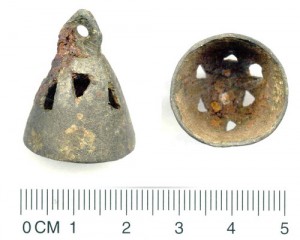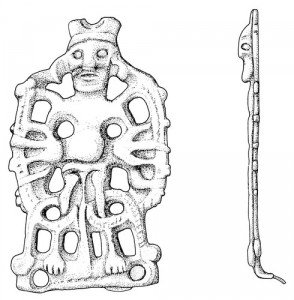August 6th, 2008 by Steve Ashby
Finally, finally, I get to the Vikings. This is where it gets interesting. But first we have to deal with the Middle Saxon period (c. AD 650-850). Some would say that the period between the end of the ‘Pagan’ period and the arrival of Scandinavian raiders and settlers is under-appreciated, and there is indeed much to learn about the archaeology of this period, and much that metal-detected data can offer.
The Middle Saxon Period
Northamptonshire is, as those of you who live there know (or should do) pretty centrally placed within modern England. That meant that between the 6th and 9th centuries, it fell within the lands controlled by the Kings of Mercia, of whom Offa (ruled AD 757-796) is undoubtedly the most famous. It’s worth dwelling a little bit on this period, because it’s something we Midlanders can be a little proud of (certainly, for some of us, its our greatest moment pre-May 16th 1987).
By the time of Offa, Mercia had extended its dominion over much of southern England. Offa founded a number of market towns in the region, began minting coins, and involved himself in the administration of the church. He held considerable authority, discernible through his commissioning of Offa’s Dyke, and through his negotiations with Charlemagne. Soon after the time of Offa, the pendelum of power swung in favour of Wessex, though the star of that county was also to be short-lived, given the imminent arrival of Scandinavian raiders, settlers, and mercenaries.
So much for the history. As for the archaeology of settlement, by the Middle Saxon period, land was divided into major logistical units, within which centres developed. In Northants, Hamtun (Northampton) was a key example, and in AD 750 a great hall’was constructed there. Excavations on St Peter’s Street recovered what was at first thought to be a Saxon palace , but is perhaps more properly described as part of a minster complex.
So what can the PAS add to this picture? Well, a search of early medieval finds in the county brings up a number of 8th and 9th-century strapends and similar dress fittings. The value of these finds is in their spatial analysis, both on a county and national scale, but that’s for another day. In addition to these finds, there are a few more unusual objects, such as this decorative sword pommel (which might be indicative of an elite presence and/or military activity in the area), and this pin beater (a tool used for beating weft when weaving textiles). Early medieval swords and associated objects are not common finds, while bone tools are reasonably well known from urban excavations, but less so as spotfinds.
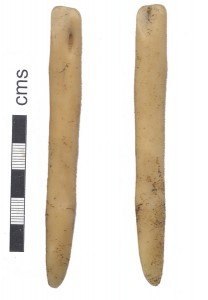
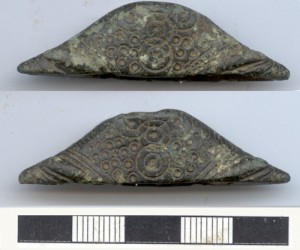
Of course, the other thing we shouldn’t forget about are coins. We have 9 sceattas from the county, including this unusual (probably continental) variety. Their distribution remains to be analysed, but when we have a few more examples it may tell us a lot about settlement and market activity in Northamptonshire.
Here come the Vikings!
As I alluded to above, the Kingdom of Mercia collapsed in AD 873 with the invasion of the Danish Great Army, traditionally thought to have been led by Halfdan Ragnarsson, Ivar the Boneless, and Ubbe Ragnarsson. Later, following an eventual agreement between King Alfred the Great and Guthrum the Old, leader of the East Anglian vikings, it was agreed to divide ‘England’ (much of which was not Alfred’s to give) up into ‘Danish’ and ‘Saxon’ halves (along a line running roughly between London and Chester). In our part of the world, Watling Street (which runs right through the county, and is today marked by the line of the modern A5 road through Towcester and Daventry) was taken as a convenient and easily understood boundary, with the land to the south and west of this remaining under Alfred’s control, and that to the north and east of this becoming de facto Danish.
So, in theory Northamptonshire was cut in two, with the land west of the A5 being ‘English’, and the rest of the county being ‘Danish’. Now, it’s not as simple as that, and we know from archaeology, linguistics, and history that the two communities did not remain isolated from one another, and by the 10th century England can be said to have developed an Anglo-Scandinavian character.
On the other hand, how true was this in the 9th century? It would be interesting to see if there is much evidence of factionalism and division when this area was first divided up. Was the boundary really always more political than real, or was there a period when settlers really were forced to live on one side or another of the boundary according to their perceived ethnicity of allegiances? If so, at what date (and why?) did this begin to change? The reality of the Danish presence in north Northamptonshire is shown by the concentration of place names ending by and thorpe, and the way in which the historic parishes tend to butt up against the line of Watling Street is suggestive of its longheld significance as a boundary, as well as a medium of communication. However, it is through archaeology, and through everyday finds such as dress accessories in particular, that we might be able to find out more about Norse-native contact and cultural identity in the early Viking Age. So, it would be useful to know whether detectorists and members of the public are finding many 9th and 10th century objects of true Scandinavian character, of true ‘Anglo-Saxon’ design, or cheap imitations of either. So let us know about your Jellinge brooches, cloissonne brooches, Winchester style strap ends and nasty bits of early medieval lead.
‘But what do we have so far?’, I hear you ask. Well, there’s not an awful lot of late Saxon/Viking Age data for Northants at the moment, but what there is I hope to publish in the near future. For the time being, here’s a taster of some of the bits and pieces that have come up.
As I mentioned above, there are a number (c.30 at the time of writing) of ‘Saxon-looking’ strapends (see this one, for example ) though in many cases it is difficult to say whether these date to the 9th century or earlier. More definitively Viking-Age is this distinctive Jellinge style disc brooch which perhaps represents the presence of someone who had travelled over from southern Scandinavia, or a local attempt to look as such (a lug on the reverse suggest that it may have been used as a pendant, which is perhaps indicative of a true Scanbdinavian origin). Further research is required in this area (and I intend to do as such!).
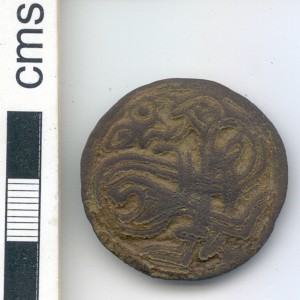
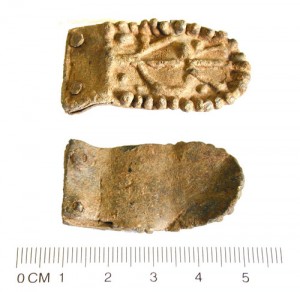
Lead alloy strapend
In 10th and 11th-century England, we see the copying of Scandinavian styles of jewellery and dress accessory in cheaper materials, From South Northants, we have this lovely (and naff) lead strapend. The period also sees the development of distinctive ‘hybrid’ forms of material culture, known as the Anglo-Scandinavian and Hiberno-Norse schools. The latter is represented by distinctive ‘Norse bells’, which seem to come originally from the Irish Sea area, and may have been dress accessories, or could perhaps have had a role in falconry. There is a good example from South Northants, which is all the more interesting as its decoration is not typical of the type.
